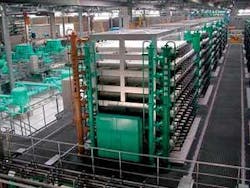by Nikolay Voutchkov
Pretreatment is an integral part of every seawater reverse osmosis (SWRO) desalination plant. The key purpose of the pretreatment system is to remove particulates, debris, microorganisms, suspended solids and silt from the source seawater prior to reverse osmosis separation. Ideally, after pretreatment the only solids left in the seawater would be the dissolved minerals. As long as the seawater system is operated in a manner that prevents minerals from precipitating on the membrane surface, the SWRO membranes could operate without any cleaning for a very long time. Practical experience shows that in close-to-ideal source seawater quality, SWRO membranes may not need to be cleaned for one to two years and their useful life could extend beyond 10 years.
In actuality, however, pretreatment systems remove most but not all of the suspended solids contained in the seawater. The suspended solids, particulates and silt that remain after pretreatment accumulate on the surface of the RO membranes and cause loss of membrane productivity over time. In addition, because seawater naturally contains bacteria as well as dissolved organics, a biofilm of bacteria can form on the membrane surface.
All membranes foul over time. However, the rate and reversibility of fouling are the two key factors that have most profound effect on the performance and efficiency of the seawater reverse osmosis separation process. These factors in turn are closely related to the source seawater quality and the performance of the desalination plant's pretreatment system.
Two types of pretreatment systems are typically used to protect the SWRO membranes from fouling: conventional granular media filtration and membrane filtration. Currently, conventional granular media filtration is the predominant pretreatment technology for large and medium size desalination plants. Conventional seawater pretreatment filters have configuration and media similar to those used in fresh water filtration applications and could be either gravity or pressure-driven. Gravity pretreatment filters have been used for some of the largest SWRO desalination plants in the world, including the 86 mgd Ashkelon plant in Israel.
Membrane filtration for seawater pretreatment is relatively new. At present, less than half a dozen full-scale seawater desalination plants worldwide are using membrane pretreatment. These systems apply ultrafiltration (UF) or microfiltration (MF) membranes installed in modules through which source seawater is filtered using either pressure or vacuum.
The largest full-scale seawater membrane pretreatment system in the world is located at the 37 mgd (140,000 m³/day) SWRO plant in Addur, Bahrain. That plant, as well as the largest membrane pretreatment system in Asia, located at the 25 mgd (96,000 m³/day) Fukuoka desalination plant in Japan, uses pressure-driven UF membranes.
Many recent studies have indicated that membrane filtration technologies have a number of advantages for seawater pretreatment as compared to conventional granular media filtration systems. Granular media filtration, however, is a well understood and has a number of features that render it very cost-competitive and viable. Therefore, the selection of filtration technology for seawater pretreatment should be based on a thorough life-cycle cost-benefit analysis.
Side-by-side pilot testing of the two types of systems is also highly recommended to develop background system performance information. The following issues should be taken into consideration when selecting between granular media and membrane pretreatment filtration for seawater desalination.
Seawater Quality
Micro- and ultrafiltration have a wider spectrum of particle removal capabilities than conventional media filtration. Single or dual-media filters usually have lesser removal efficiency in terms of raw water organics in suspended form, disinfection byproduct precursors, fine particles, silt and pathogens. Membrane filtration technologies are also less prone to upsets caused by seasonal changes in source water temperature, pH, turbidity, color, pathogen contamination, and size and type of water particles, because their primary treatment mechanism is a mechanical particle removal through fine-pore membranes. Therefore, upstream chemical coagulation and flocculation are of a lesser importance for their consistent and efficient performance.
In contrast, the pretreatment efficiency of conventional media filtration technologies is very dependent on the efficiency of chemical coagulation and flocculation ahead of the filtration process. Typically, coagulation and flocculation water chemistry is more sensitive to changes in seasonal water quality than the mechanically driven membrane particle separation processes.
Therefore, for applications where intake water quality experiences significant seasonal variations and presents a challenge in terms of high pathogen, fine particles and elevated particulate organics contamination, membrane filtration technologies are likely to offer performance benefits. However, if the source water for the desalination plant is collected from an open intake located far from the surf zone and at adequate depth to be exposed to only limited seasonal variations (typically 20 meters or deeper), granular media filtration may offer a very cost-effective pretreatment alternative to membrane filtration.
Source seawater temperature is a very important factor when selecting a pretreatment system. Application of vacuum driven membrane pretreatment systems is usually less cost-effective than pressure membrane filtration and conventional granular media filtration for seawater of temperature lower than 12 ºC, because the productivity (flux) of vacuum-driven membrane filtration is dramatically reduced by the significant increase in unit weight of seawater at low temperature.
Seawater can contain particles that are finer and sharper than the particles usually occurring in fresh surface water or wastewater effluent. Experience with fresh surface source water (such as rivers or lakes) or wastewater indicates that 500-micron screens are adequate to protect membranes from damage. However, numerous tests at the Carlsbad Seawater Desalination Demonstration Plant and West Basin Seawater Pilot Plant in California indicate that screen size larger than 120 microns does not provide adequate protection of the membranes against sharp particles found in seawater.
In addition, seawater contains barnacles, which in their embryonic phase of development are 130 to 150 microns in size and can pass the screen openings unless they are 120 microns or smaller. If barnacle plankton passes the screens, it attaches to the walls of downstream pretreatment facilities, grows on the walls and ultimately interferes with pretreatment system operations. Once barnacles establish colonies in the pretreatment facilities and equipment they are very difficult to remove and can withstand chlorination, which is an effective biocide for most other marine organisms.
Therefore, the use of fine micro-screens (80 to 120-micron size) is essential for reliable operation of the entire seawater desalination plant using membrane pretreatment.
Micro-screens are not needed for pretreatment systems using granular media filtration because these systems effectively remove barnacles in all phases of their development. The performance and reliability of conventional granular media pretreatment systems also are not sensitive to sharp objects in the seawater and do not require elaborate and costly micro-screening ahead of the filters. Typically, fine traveling screens of 1/8 to 3/8-inch (3 to 10 mm) openings provide adequate protection of conventional granular media pretreatment systems.
On the other hand, the use of membrane pretreatment eliminates the need for a cartridge filter system ahead of the SWRO pumps. Cartridge filters are needed when granular filtration systems are used for pretreatment in order to protect the downstream SWRO membranes from damage caused by fine sand particles which may be occasionally conveyed with the pretreated seawater.
Algal blooms
Occurrence of frequent and prolonged red tides or other algal blooms in the area of the seawater intake is another important factor to consider when selecting the type and configuration of pretreatment systems. Many of the marine micro-algae which grow excessively during algal blooms cannot withstand external pressure of more than 0.5 bars and their cells would break when exposed to pressure or vacuum-driven filtration. When algal cells break, they release easily biodegradable organic compounds, which could trigger accelerated growth and formation of biofilm on the SWRO membranes.
The accelerated biofilm formation can foul SWRO membranes and result in significant reduction of desalination plant production capacity within several weeks from the beginning of the algal bloom.
In such source water conditions, gravity down-flow granular media filtration may be more desirable because it gently removes micro-algae from the source water without breaking their cells and creating accelerated fouling of the SWRO membranes.
If membrane pretreatment is selected for desalination plants with open ocean intakes prone to frequent and extensive red tides or algal blooms, the use of dissolved air flotation (DAF) or granular media filtration system ahead of the membrane pretreatment facility is highly recommended.
Conclusion
Membrane seawater pretreatment is an attractive alternative to conventional granular media filtration. However, taking under consideration the numerous factors affecting the pretreatment costs of a full-scale seawater desalination plant, the selection of the most suitable pretreatment system for a given project has to be based on a thorough life-cycle cost analysis which accounts for all expenditures and actual costs associated with the installation and operation of the two systems.
As the desalination industry gains long-term experience with the operation of membrane pretreatment systems in the next five to 10 years and the existing membrane technologies evolve and converge into compatible, standardized and commoditized products, the use of UF or MF membranes for seawater pretreatment is expected to become more competitive and attractive. Meanwhile, conventional granular media filtration is expected to continue to dominate seawater applications in the near future.—m
About the Author
Nikolay Voutchkov, PE, BCEE, is a Chief Technology Officer and Corporate Technical Director for Poseidon Resources, a US company specialized in developing of large water infrastructure projects. He is one of the principal authors of the latest edition of the AWWA Manual on Reverse Osmosis and Nanofiltration and the new WHO Desalination Guidelines.
Books Examines Desalination Pretreatment
A new book entitled “Pretreatment Technologies for Membrane Seawater Desalination has been published by the Australian Water Association. The book, written by Nikolay Voutchkov, presents an overview of pretreatment challenges facing most reverse osmosis seawater desalination plants today and provides practical solutions derived from worldwide experience. The reader will find guidelines for selection of pretreatment system configuration based on source seawater quality and for design of the most commonly used pretreatment technologies, such as screening, sand removal, sedimentation, dissolved air flotation, granular media filtration and membrane filtration.
For more information, visit the Bookstore on the Association's website, www.awa.asn.au.






